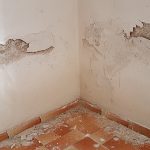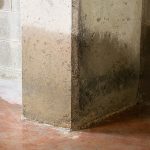What to Do When You Find Water Damage: 12 Steps
Discovering water damage in your home or business is unsettling. From subtle stains on the ceiling to a full-on flood, any water damage greatly impacts the value of the building and risks your safety. This is especially true when it involves key structural elements like ceilings. It demands a swift, strategic response to mitigate further loss and begin the restoration process.
Water damage ranges from cosmetic to structural threats, with potential long-term consequences if not appropriately addressed. Water damage restoration is about more than repairing what is visible to the eye. It’s ensuring the safety and longevity of your property.
On top of the physical damage, it causes emotional distress. Dealing with the unknown of how extensive the damage is, how long it will take to repair it all, and the stress of working with insurance companies is more than enough to drain anyone.
After discovering water damage, taking the proper steps makes a difference. Protect your space, preserve your peace of mind, and lay the groundwork for an effective recovery. This guide is your beacon through the storm, illuminating the essential steps to reclaim your space, preserve your peace of mind, and lay a solid foundation for restoration.
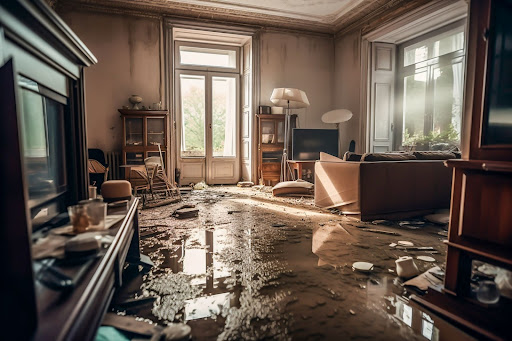
Understanding Water Damage
When water invades your space, it does more than dampen surfaces. The water seeps into the fabric of your home, threatening the foundation of your cherished space.
Water damage is a term that often feels too sterile to describe the chaos it brings into your life. It’s more than the physical intrusion of water — the silent havoc it wreaks, sometimes hidden from view, erodes the safety you’ve built.
The unwelcome water comes in multiple forms. Each comes with its own level of urgency and approach to remediation.
From the sudden catastrophe of a burst pipe to the creeping menace of a slow leak, water damage ranges from a blatant flood to a deceptive stain on the ceiling. The latter often goes unnoticed until the damage has reached a critical point, compromising the integrity of your home and your family’s health.
Understanding the types of water damage is the first step in crafting an effective response plan.
Types of Water Damage
The types of water damage can be broadly categorized into three groups:
Clean Water Damage: Originating from sanitary sources such as supply lines or rainwater, this type of damage is generally considered the least hazardous but has the potential to escalate if not immediately addressed.
Grey Water Damage: This involves used water and may contain contaminants. Appliances like dishwashers and washing machines are common culprits. While not immediately harmful, grey water can degrade into more toxic forms if neglected.
Black Water Damage: The most severe category, black water, comes from unsanitary sources such as sewage and floodwaters. It poses immediate health risks and requires urgent professional attention.
The Silent Aftermath
Untreated water damage extends far beyond the initial wetness. Left unchecked, it leads to discoloration and destruction of walls and ceilings, warping of hardwood floors, and the emergence of a musty odor, heralding the onset of mold.
Understanding the nature of water damage is your first line of defense. It empowers you to recognize the signs early and take decisive action to protect your home, your health, and the memories held within your walls.
Potential Consequences of Untreated Damage
Unchecked water damage leads to a host of problems. In the short term, it causes discoloration and damage to walls and ceilings, warp floors, and produces a musty odor indicating mold. Over time, the property’s structural integrity becomes compromised, leading to more significant safety concerns.
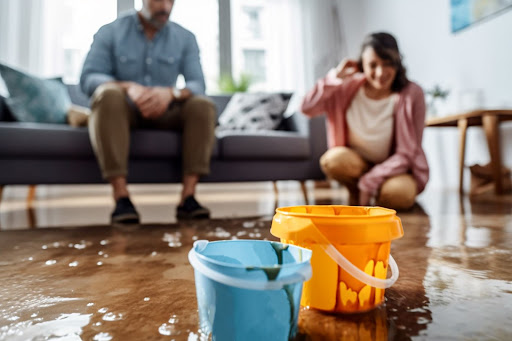
Water damage to ceilings is particularly concerning as it severely weakens the roof’s structural components. It poses a risk of collapse if not properly remediated. On top of structural components, damp environments are breeding grounds for mold and mildew, which affect people’s health and further degrade property.
The emotional toll it takes on homeowners and residents in the wake of water damage often gets overlooked. The disruption of daily life, the loss of personal items, and the uncertainty of recovery are overwhelming and discouraging.
Acknowledge these feelings and seek support when necessary. Lean on family and friends, consult with counselors, or join community groups to find the support you need. Recovery is a holistic process that involves mending the home and the hearts of those who dwell within it.
Immediate Actions to Mitigate Damage
When faced with water damage, your actions in the immediate aftermath heavily influence the extent of the ruin and the scope of the water damage restoration efforts required.
Here’s what you need to do right away to mitigate the damage:
Step 1: Safety First – Ensuring a Safe Environment
Before diving into any cleanup efforts, ensure the environment is safe. Water damage compromises the structural integrity of buildings. This is particularly true with water damage to ceilings, which may lead to collapse. Be wary of electrical hazards and wear protective gear if you must enter flooded areas.
If there are any doubts about safety, wait for professionals to assess the situation.
Step 2: Stop the Source – Identifying and Halting Water Flow
If it’s safe to do so, identify the source of the water damage. It could be a leaky roof or a burst pipe. Whatever the cause, stop the flow of water before it gets worse.
If it’s a plumbing issue, this means shutting off the main water supply to your home. For leaks from natural sources, like a hole in the roof, temporary measures are necessary until repaired.
Step 3: Protect Your Belongings – Moving and Securing Property
Water will wreak havoc on your possessions. Move any items you can to a dry area to prevent further damage. Prioritize Important documents, electronics, old photographs, and other valuables. If furniture or heavy items are too difficult to move, consider placing aluminum foil or wood blocks under the legs to prevent direct contact with wet carpets or floors.
By taking these immediate actions, you’ll help minimize the impact of water damage and set the stage for effective restoration. Remember, when it comes to water damage, every minute counts. Acting swiftly and safely will save you time, money, and stress.
Documenting the Damage
In the wake of water damage, amidst the urgency to clean and repair, don’t overlook clear documentation of the damage. This meticulous process is a cornerstone of the water damage restoration journey, as it serves as a vital record for insurance claims, working with restoration companies, and future reference.
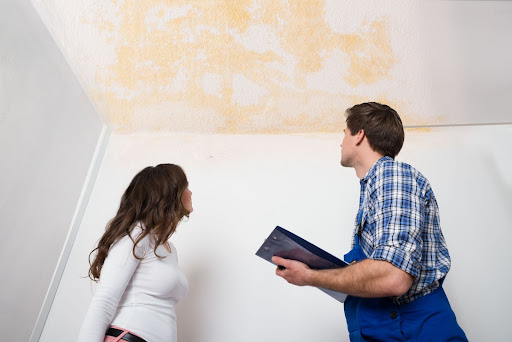
Step 4: Detailed Documentation – Taking Photos and Notes
Begin by taking extensive photographs of the ruined areas. Capture the extent of the water damage from multiple angles, including shots of water damage to ceilings, walls, floors, and personal belongings. The more detailed your visual records, the better.
Alongside photos, take detailed notes of the damage observed, including the time and date you first noticed the water damage and any steps you’ve taken since. Keep digital backup copies for safekeeping as you work through the restoration and insurance claims process.
Step 5: Keep Records – Organizing Receipts and Related Documents
As you move forward with the water damage restoration process, keep a diligent record of all correspondence and transactions. This should include insurance records, restoration quotes, and store receipts for any expenses incurred — protective materials, temporary housing, or professional services. These documents will allow you to file an extensive insurance claim with a clear trail of the water damage’s financial impact.
Armed with thorough documentation, you can approach the water damage restoration process with a solid foundation of evidence. This will be instrumental in ensuring you receive a fair assessment and compensation for the damage.
Remember, while the physical restoration is vital, safeguarding the financial investment in your property is equally important. Proper documentation empowers self-advocacy throughout the restoration and claims process.
Navigating Insurance Claims
Dealing with water damage is stressful enough without the added complexity of insurance claims. Unfortunately, navigating insurance is a crucial step for water damage restoration.
Here’s how to approach it with the diligence and attention it requires.
Step 6: Review Your Policy – Understanding Coverage
Before you file a claim, you need to understand what your insurance policy covers. Review your policy documents carefully to determine the extent of coverage for water damage, including specific provisions for water damage to ceilings and other structural elements.
Look for details on coverage limits, deductibles, and any exclusions that might apply. If the language is unclear or you have questions, contact your insurance provider for clarification.
Step 7: Immediate Reporting – Contacting Your Insurance Company
Once you have a grasp on your coverage, report the water damage to your insurance company as soon as possible. Most policies require prompt reporting of the damage. Delays may affect the outcome of your claim.
When you contact your insurer, be prepared to provide the compilation of detailed documentation you’ve gathered. This is all the photos, notes, and receipts you’ve gathered. They will likely assign an adjuster to handle your claim and assess the damage in person.
As you move through the claims process, remember that the goal is to secure funds for a thorough water damage restoration. This means cleaning up the water and repairing any structural damage to your home, including walls, ceilings, and floors.
Be proactive in communicating with your insurance adjuster and ensure they understand the full scope of the damage for your claim to accurately reflect the restoration work needed.
The Role of a Public Adjuster
The path to restoration has its complexities, particularly regarding insurance claims. This is where the expertise of a public adjuster is invaluable. A public adjuster advocates for the policyholder, navigating the intricacies of insurance claims to ensure fair compensation.
Step 8: Expert Assessment – Scheduling an Inspection with a Public Adjuster
A public adjuster will thoroughly inspect the water damage, providing an independent, more comprehensive assessment than that of an insurance company’s adjuster. They pay meticulous attention to all areas touched by water damage, including hidden damage and internal structures that may not be immediately apparent.
Step 9: Filing Your Claim – How a Public Adjuster Can Help
Armed with an expert evaluation, a public adjuster will assist you in filing your insurance claim to effectively present all the necessary documentation and evidence of water damage. They understand the nuances of insurance policies and will articulate the extent of the damage and required water damage restoration work in terms that align with the language of your policy.
Step 10: Claim Negotiation – Advocating for a Fair Settlement
A public adjuster’s most critical role is in the negotiation phase. They engage with the insurance company on your behalf, using their knowledge and experience to negotiate a settlement that truly reflects the claim’s value.
They aim to secure a payout covering all aspects of the water damage restoration, from initial cleanup to final repairs. They help you get the resources needed to return your property to its pre-damage state.

The involvement of a public adjuster will put someone in your corner. They act as dedicated allies who are equipped to handle the complexities of the claims process and allow you to focus on the immediate needs of your property and personal well-being.
With a public adjuster’s expertise, navigate the aftermath of water damage with an advocate by your side, championing your best interests and a fair resolution.
Repair and Restoration
Once the immediate aftermath is handled and the insurance claims are underway, the focus shifts to the repair and restoration of your property. This phase is about bringing your space back to life, addressing all the ruined areas from the water, and ensuring the integrity and safety of your home or business.
Step 11: Choosing the Right Contractors – Tips and What to Look For
Selecting contractors for the water damage restoration process is an imperative decision. Look for licensed, insured, and experienced professionals with a track record of handling water damage, especially if there is significant water damage to ceilings or other structural components.
Seek contractors who are transparent about their process, provide detailed estimates, and have positive references or reviews from past clients. Recommendations from friends and family who have experience working with contractors are a good place to start your search for the right company.
Getting multiple bids is also recommended to ensure you receive fair and competitive restoration work pricing.
Step 12: Restoring Your Property – The Path to Pre-Damage Condition
The actual restoration work ranges from simple repairs to complete overhauls, depending on the extent of the water damage. This typically involves water extraction, drying, and dehumidification to remove all moisture.
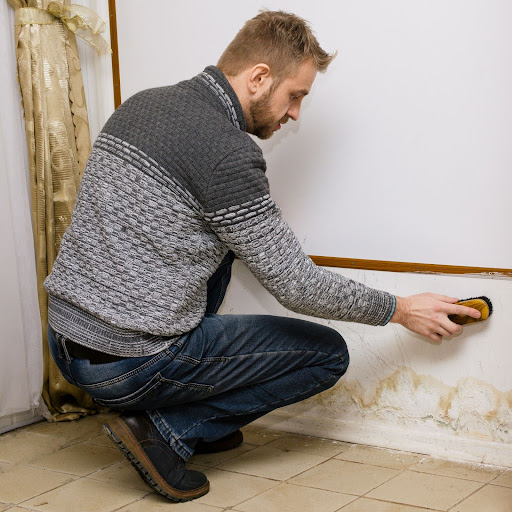
True restoration goes beyond the visible. It’s a comprehensive process that involves:
- Extraction and Drying: Remove every trace of moisture to prevent further degradation.
- Sanitization: Ensure your home is visually appealing while also hygienically safe to live in after the damage.
- Structural Repair: Address the bones of your home, ensuring that every repair contributes to the longevity and safety of your space.
- Aesthetic Revival: Reinstate the beauty of your interiors, from the paint on the walls to the finish on the floors.
Throughout the repair and restoration process, it’s important to maintain open communication with your contractors, guaranteeing the work aligns with the agreed-upon scope and quality.
Remember, water damage restoration is fixing what’s broken while preventing future issues and restoring your property to a condition that’s better than before the water damage.
Preventative Measures: Safeguarding Your Home Against Future Water Damage
The adage “an ounce of prevention is worth a pound of cure” holds true when it comes to protecting your home from future water damage. While the restoration process heals the wounds inflicted, taking proactive steps to prevent damage goes a long way for the safety and integrity of your property.
Here are key strategies to fortify your home:
Regular Maintenance Checks:
Plumbing Vigilance: Regularly inspect pipes, faucets, and appliance connections to catch leaks early. Consider installing a water leak detection system that alerts you to the presence of moisture before it becomes a problem.
Roof Inspections: Have your roof inspected annually and after any major weather event to ensure no missing shingles, damaged flashing, or other vulnerabilities that may allow water to seep in.
Climate and Weather Preparedness:
Weatherproofing: Seal windows and doors and ensure that your home’s exterior is equipped to handle your local climate, be it heavy rains, snow, or flooding conditions.
Gutter Maintenance: Keep gutters and downspouts clear of debris to prevent water from pooling and causing damage to your roof or foundation.
Landscaping and Exterior Considerations:
Proper Drainage: Ensure your property is graded to direct water away from your foundation. Install French drains or sump pumps if you live in an area prone to flooding.
Vegetation Management: Keep trees well-trimmed and away from utility lines and your home’s structure to prevent damage during storms.
Emergency Preparedness:
Emergency Kit: Keep an emergency kit with important documents, basic tools, protective gear, and water damage mitigation supplies like sandbags or water barriers.
Integrating these preventative measures into your routine home maintenance reduces the risk of water damage. It’s about creating a resilient home environment that stands firm against the elements, ensuring peace of mind and the enduring safety of your sanctuary.
Quick Checklist for Water Damage Response:
Safety First:
Turn off electricity to the affected areas before entering.
Wear protective gear if necessary (gloves, masks, boots).
Stop the Source:
Identify and stop the water source if possible (e.g., shut off the main water valve).
Protect Your Belongings:
Move valuables and furniture away from the water.
Place aluminum foil or wood blocks under furniture legs to prevent staining and moisture absorption.
Document the Damage:
Take photos and videos of the damage from multiple angles.
Make a list of all damaged items.
Contact Insurance:
Notify your insurance company immediately to start the claims process.
Remove Water:
If safe, begin removing water by mopping or using a wet vacuum.
Ventilate and Dehumidify:
Open windows and doors to increase airflow if the weather permits.
Use fans and dehumidifiers to help dry out the area.
Remove Wet Items:
Take out wet carpets, bedding, and furniture to dry.
Discard items that are heavily damaged and cannot be salvaged.
Clean and Disinfect:
Clean all wet areas with appropriate cleaners to prevent mold growth.
Disinfect to kill any bacteria or pathogens present.
Contact a Restoration Professional:
Hire a professional water damage restoration service for proper cleanup and repair.
Keep Records:
Keep a log of all conversations, transactions, and activities related to the water damage and restoration process.
Review Your Policy:
Revisit your insurance policy to understand coverage details.
Seek Professional Advice:
Consider consulting with a public adjuster if the insurance settlement offer is insufficient.
Plan for Repairs:
Get estimates from contractors for repair work.
Schedule repairs once the insurance claim is settled.
Prevent Future Damage:
Investigate the cause of the damage and take preventive measures to avoid future incidents.
Handling Water Damage Claims With Hudson Douglas Public Adjusters
In the aftermath of water damage, restoration is a complex challenge. It requires a clear head, a methodical approach, and taking each step in the process one at a time. From the initial assessment of the damage to the final touches of restoration work, every action impacts the recovery of your property.
We’ve outlined the steps to take when encountering water damage, emphasizing the importance of safety, swift action to mitigate further damage, meticulous documentation, and the strategic navigation of insurance claims.
We’ve also highlighted the role of public adjusters, like Hudson Douglas Public adjusters, in advocating for your rights and ensuring you receive a fair settlement to cover water damage restoration costs.
As you progress with repairs and claims for water damage to ceilings, walls, or any part of your property, remember that restoration is about reclaiming your space. Home should be a safe, secure, and welcoming place. Let our trusted team at Hudson Douglas Public Adjusters advocate for you to get your home back.
Call Hudson Douglas Public Adjusters today for a free claim review at 480-320-9580.



